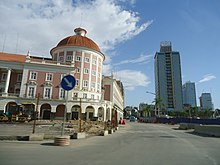Economy of Angola

|
|
| Currency | Angolan kwanza (AOA) |
|---|---|
| Calendar Year | |
|
Trade organisations
|
AU, African Development Bank, SADC, World Bank, IMF, WTO, Group of 77, OPEC |
| Statistics | |
| GDP |
Rank: 66 (2012 est.) |
|
GDP growth
|
5.4% (2014), 3.0% (2015), 0.4% (2016e), 1.2% (2017f) |
|
GDP per capita
|
$6,500 (PPP) (2012 est.) Rank: 144 (2012 est.) |
|
GDP by sector
|
agriculture 10.2% industry 61.4% services 28.4% (2011 est.) |
|
|
|
|
Population below poverty line
|
40.5% (2006 est.) |
| N/A | |
|
Labour force
|
8.468 million (2012 est.) |
|
Labour force by occupation
|
agriculture 85% industry and services 15% (2003 est.) |
| Unemployment | N/A |
|
Main industries
|
petroleum, uranium, diamonds, gold, bauxite, iron ore, phosphates, feldspar, metal products, fish processing, food processing, brewing, tobacco products, sugar, textiles, commercial ship repair |
| 182nd (2017) | |
| External | |
| Exports |
|
|
Export goods
|
crude oil, petroleum products, diamonds, fish, fish products, coffee, sisal, cotton, lumber |
|
Main export partners
|
|
| Imports |
|
|
Import goods
|
machinery, electrical equipment, vehicles and spare parts, military technology, medicines, textiles, food |
|
Main import partners
|
|
|
FDI stock
|
|
|
Gross external debt
|
|
| Public finances | |
|
|
|
|
|
|
| Revenues | $51.24 billion (2012 est.) |
| Expenses | $44.23 billion (2012 est.) |
| Economic aid | $383.5 million (1999 est.) |
|
Foreign reserves
|
|
The Economy of Angola is one of the fastest-growing in the world, with reported annual average GDP growth of 11.1 percent from 2001 to 2010. It is still recovering from 27 years of the civil war that plagued the country from its independence in 1975 to 2002. Despite extensive oil and gas resources, diamonds, hydroelectric potential, and rich agricultural land, Angola remains poor, and a third of the population relies on subsistence agriculture. Since 2002, when the 27-year civil war ended, the nation has worked to repair and improve ravaged infrastructure and weakened political and social institutions. High international oil prices and rising oil production have contributed to the very strong economic growth since 1998, but corruption and public-sector mismanagement remain, particularly in the oil sector, which accounts for over 50 percent of GDP, over 90 percent of export revenue, and over 80 percent of government revenue.
The Portuguese explorer Diogo Cão reached the Angolan coast in 1484, after which Portugal began to found trading posts and forts along the shore. Paulo Dias de Novais founded Sāo Paulo de Loanda (Luanda) in 1575. São Felipe de Benguella (Benguela) followed in 1587.
The principal early trade was in slaves. Portuguese merchants purchased the slaves from the local Imbangala and Mbundu peoples, notable slave hunters, and sold them to the sugarcane plantations in Brazil. Brazilian ships were frequent visitors to Luanda and Benguela and Angola functioned as a kind of colony of Brazil, with Brazilian Jesuits active in its religious and educational centers.
...
Wikipedia
